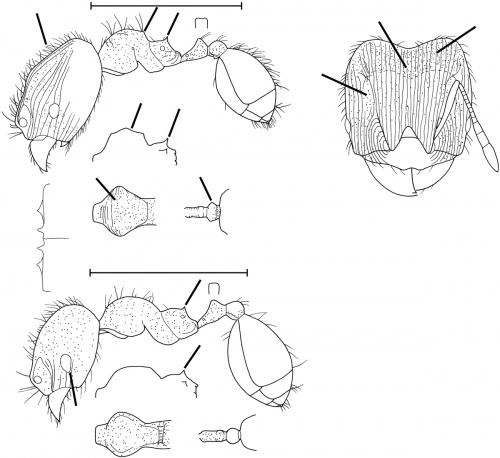Pheidole pholeops
| Pheidole pholeops | |
|---|---|
| Scientific classification | |
| Kingdom: | Animalia |
| Phylum: | Arthropoda |
| Class: | Insecta |
| Order: | Hymenoptera |
| Family: | Formicidae |
| Subfamily: | Myrmicinae |
| Tribe: | Attini |
| Genus: | Pheidole |
| Species: | P. pholeops |
| Binomial name | |
| Pheidole pholeops Wilson, 2003 | |
Cover and Tobin collected several colonies at the type locality (Cuzco Amazónico, Peru) in terra firme forest and forest transitional between terra firme and seasonally flooded forest, nesting in rotting sticks and logs on the forest floor and (in one case) in the soil. (Wilson 2003)
Identification
See the description in the nomenclature section.
Keys including this Species
Distribution
Known from the type locality; from the vicinity of Manaus, Amazonas, Brazil; and from Yasuni National Park, Puerto Tipugini, Ecuador. (Wilson 2003)
Latitudinal Distribution Pattern
Latitudinal Range: -0.6258° to -12.497473°.
| North Temperate |
North Subtropical |
Tropical | South Subtropical |
South Temperate |
- Source: AntMaps
Distribution based on Regional Taxon Lists
Neotropical Region: Brazil, Ecuador, Peru (type locality).
Distribution based on AntMaps
Distribution based on AntWeb specimens
Check data from AntWeb
Countries Occupied
| Number of countries occupied by this species based on AntWiki Regional Taxon Lists. In general, fewer countries occupied indicates a narrower range, while more countries indicates a more widespread species. |

|
Estimated Abundance
| Relative abundance based on number of AntMaps records per species (this species within the purple bar). Fewer records (to the left) indicates a less abundant/encountered species while more records (to the right) indicates more abundant/encountered species. |

|
Biology
Castes
Nomenclature
The following information is derived from Barry Bolton's Online Catalogue of the Ants of the World.
- pholeops. Pheidole pholeops Wilson, 2003: 487, figs. (s.w.) PERU.
Unless otherwise noted the text for the remainder of this section is reported from the publication that includes the original description.
Description
DIAGNOSIS Similar to Pheidole asperithorax, Pheidole exigua, Pheidole flavens and Pheidole nuculiceps, differing as follows.
Major: a small depression in the posterior center of the vertex gives an illusion of a hole; posterior dorsal profile of head very feebly concave; promesonotum raised, with two pronotal and one angular mesonotal convexity in dorsal-oblique view; postpetiole diamond-shaped; faint antennal scrobes present; almost all of dorsal surface of head carinulate and foveolate; all of mesosoma foveolate, and anterior third of pronotum carinulate.
Minor: eye large and set forward on head; propodeal spines reduced to denticles; all of dorsal surface of head and mesosoma foveolate.
MEASUREMENTS (mm) Holotype major: HW 0.70, HL 0.76, SL 0.40, EL 0.12, PW 0.34. Paratype minor: HW 0.34, HL 0.36, SL 0.32, EL 0.08, PW 0.22.
COLOR Major: body light brownish yellow (“bronze”), appendages clear medium yellow.
Figure. Upper: holotype, major. Lower: paratype, minor. Scale bars = 1 mm.
Type Material
PERU: Cuzco Amazónico, 15 km northeast of Puerto Maldonado, Madre de Dios, col. Stefan Cover and John Tobin. Museum of Comparative Zoology
Etymology
Gr pholeops, like a hole, or cavity, referring to illusion of a small hole in vertex.
References
- Wilson, E. O. 2003. Pheidole in the New World: A dominant, hyperdiverse ant genus. Harvard University Press, Cambridge, MA. (page 487, fig. major, minor described)
References based on Global Ant Biodiversity Informatics
- Fernández, F. and S. Sendoya. 2004. Lista de las hormigas neotropicales. Biota Colombiana Volume 5, Number 1.
- Mertl A. L., J. F. A. Traniello, K. Ryder Wilkie, and R. Constantino. 2012. Associations of two ecologically significant social insect taxa in the litter of an amazonian rainforest: is there a relationship between ant and termite species richness? Psyche doi:10.1155/2012/312054
